#st. augustine gator farm
Explore tagged Tumblr posts
Text
This post made me and my bffs take a weekend road trip to St. Augustine to see the gators and the Castillo




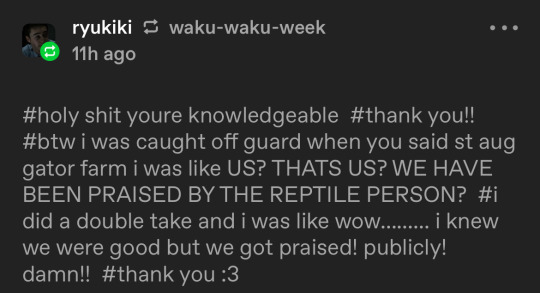
Aug ABSOLUTELY deserves the praise, @ryukikit. St. Augustine Alligator Farm is one of my favorite animal facilities, hands down. It's a pretty zoo, doable in an afternoon if you kinda like crocodilians, or an all day affair if you REALLY like crocodilians. Here are my favorite things about it and why I think it's worth supporting.
1. They keep animals in interesting social groups.

Crocodilians are heavily involved parents, but most places that breed them don't have the enclosure space to let the babies stay with the parents. St. Augustine does. One of my favorite groups was their crèche of slender-snouted crocodiles. They had the parents and then a yearling cohort and a new hatchling cohort. This aligns with how these guys live in the wild- the babies stick around longer! They have the space for it, and they are very in tune with the social needs of their animals.
Very, very few zoos can keep their baby crocs with the adults and still perform maintenance and animal health checks safely. This doesn't mean these facilities are bad- it just means that they have different management practices. And frankly, a lot of these species aren't frequently bred elsewhere. Your average zoo doesn't need a setup where you can have a multiyear crèche for slender-snouted crocodiles. Some species have better success when the young are pulled early, and some zoos are better set up to raise out any offspring separately or behind the scenes. Every facility's practices are different, and this just happens to work well at St. Augustine and be really enjoyable to see as a zoo patron.
Crocodilians are exceptional parents and very protective. It's a sign of incredible animal management practices and animals that feel very comfortable with staff that St. Augustine can do this with nearly every species they breed.
2. They understand the social needs of their animals.
Some crocodilians are social. Some are solitary. Some can live happily with a member of the opposite sex but get territorial around members of the same sex. St. Augustine pays incredible attention to their social groupings to ensure that they aren't just meeting the animals' physical health needs but their social needs as well. They do continuous scientific research about social structures in crocodilians, taking blood samples to test stress hormones and observing stress behaviors to see how group dynamics change.

For example, St. Augustine is home to one of the world's largest known living saltwater crocodiles, Maximo. And his comparatively tiny mate, Sydney. During the educational presentations with these two, they point out that even their monster of a croc needs his social group- he won't eat if she's not around and he is calmer during medical checks if he can see her. These animal share a deep and special pair bond, and they make sure to talk about how the social aspect of these animals' lives is integral to their care. It's a unique aspect of the way they talk about these animals, because he IS a spectacle and he IS a sensation, but they don't talk about him like he's a mindless killing machine- they talk about him like he's a big, complex predator with social needs like any other animal. Aug is the only facility I've been to where the emotional and social needs of crocodilians is part of the education they provide guests- and speaking of education...
3. Their demos and presentations are extremely good.
The presentations at St. Augustine are some of the best I've ever seen, and I've seen literally hundreds of animal talks on everything from aardvarks to zebras. But as you... can probably tell from my blog content, I've spent a lot of time learning about and working with reptiles. I really enjoyed all of their presentations because they are very scientific about things and avoid sensationalism. They really want you to be fascinated by these creatures and love them- but more than anything else, they want you to respect them.
Also, they do a really good job handling their ambassadors. I really enjoyed something as simple as watching an educator tell us about snakes. Throughout the whole presentation she made sure that most of the snake's body was looped in her hand. The snake was always supported and was very calm. She gave the snake plenty of head room so that it didn't feel constricted- it was just good handling all around.

But also, the presentations made it clear how much the park cares about the animals' well-being. When they do the feeding and training presentations, they make it very clear that the animals' participation is entirely voluntary. They do things differently for their 9-foot saltie and their 16-foot saltie, because the 16-footer is so large and heavy he actually struggles walking on land sometimes. They adapt their programs and his care to ensure that he's completely comfortable- and he didn't actually participate in the whole feeding when I was watching! At no point did they try to push him into anything uncomfortable; they offered, he didn't engage, and they moved on. It was a clear expression of his boundaries, and I really appreciated how much his caretakers respected that.
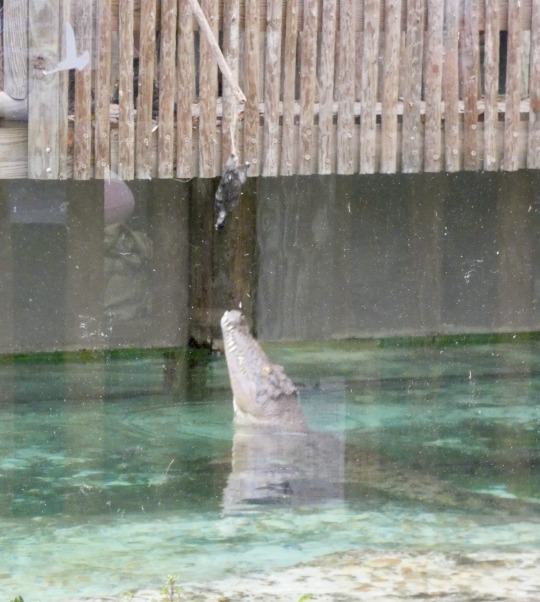
4. Ethical Interactions
I've been to... a lot of tourist locations in Florida that have animals you can hold. Almost always against my will! Many of them are pretty terrible, and you don't actually learn much, if anything. But I really found that to not be the case at St. Augustine. Every single animal presentation and interaction opportunity was accompanied by education about the animal's biology, habits, and- crucially- their conservation status.
When I held a baby alligator at St. Augustine, the proctors- there were two, one to ensure I was holding the gator correctly and the other to educate- were very informative about the role alligators play in their ecosystem and their conservation history. The animals were all properly banded, and one of the two proctors was there to ensure that none of the baby alligators were uncomfortable. As soon as they started getting squirmy or tense, they were removed, unbanded, and taken to an off-exhibit area to relax. And when the babies age out of petting size, they just go in the lagoon to live with others of their species. I saw one upset alligator the entire time I was there, and he was clearly upset that his escape attempt was foiled by a keeper during my nursery tour.
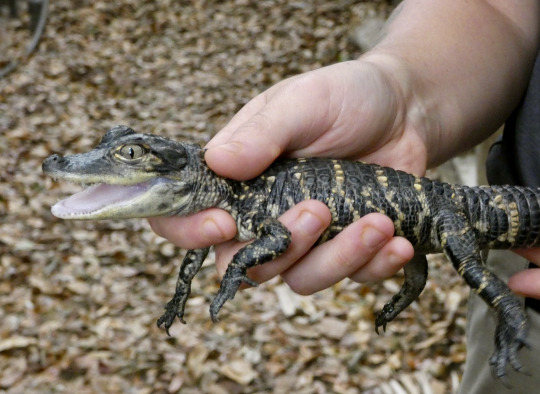
Even though he's restrained in this shot, you can see that his full body and tail are supported, and the grip, while firm, is gentle. He's distressed, but after I took this picture, she put him in his enclosure and he calmed down immediately.
Sometimes when you have petting attractions with baby animals, those animals... don't have a happy ending. (See: cub petting.) But St. Augustine's program is fine- the gators are all aged out of wanting to have mom around, there's no declawing/defanging, and they're handled with care. And it's worth it, because people love what they understand. St. Augustine was integral in raising public awareness about alligators back in the 60s when they were endangered, and now they're thriving- largely in part to programs like St. Augustine getting people to care.
And speaking of getting people to care, let's talk about their research.
5. Shared Research Results
St. Augustine is also home to more species of crocodilian than anywhere else in North America- all of them, usually. (They didn't have a Tomistoma when I visited- that may have changed.)
Because of this species diversity, it's an incredible research resource. Having every species means that you can do a lot of work comparing their behaviors, their growth patterns, and more. They've been a major research site for crocodilian biology since the 1970s. Today, they're one of the key sites for studying crocodilian play and social behaviors. They actually maintain a blog where they post copies of papers that were written using their animals, meaning that you can actually see the results of the research your admission helps fund. You can see that right here: https://www.alligatorfarm.com/conservation-research/research-blog/
All of this adds up to a zoo that provides a unique experience, tons of actual education, and transparency about what its research and conservation steps actually are. St. Augustine's come a long way since its opening in 1893, and they really do want you to leave with a new respect for the animals they care for. Ultimately, if you're a fan of reptiles, you can feel good about visiting the St. Augustine Alligator Farm- their care and keeping are top of the line, they do a ton of innovative conservation research and support for conservation organizations, and you can see this animal there:
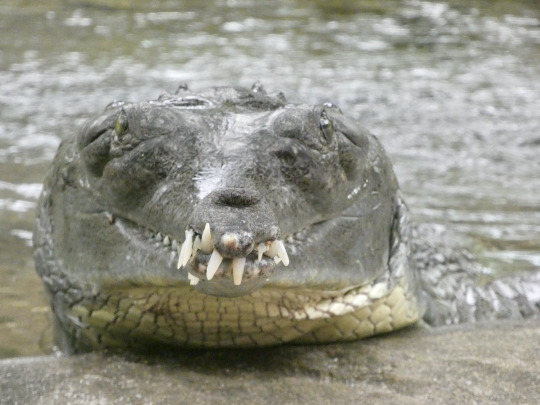
(Gharial from the front. Nothing is wrong with her that's just what they look like from the front.)
6K notes
·
View notes
Text

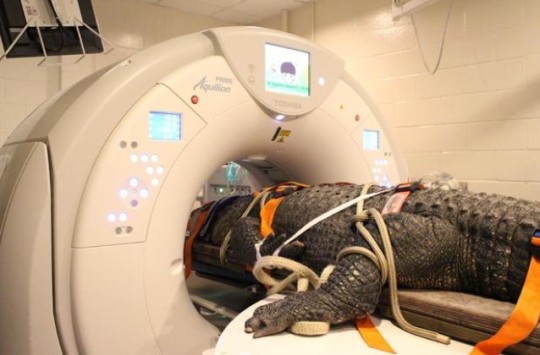
An alligator at a Florida zoo was "behaving strangely" and exhibiting abnormal symptoms. Brooke, a 376-pound gator from St. Augustine Alligator Farm Zoological Park, was exhibiting a series of symptoms, including intermittent head-rolling. According to a statement by the University of Florida College of Veterinary Medicine, the experts there used all the diagnostic tools at their disposal, including a blood draw, lung X-rays, and CT scans of Brooke's head. The hospital noted that clinicians had to use both X-rays and CT scans because "Brooke was too large to perform a complete CT scan of his body." With all that information at their fingertips, the team soon made a diagnosis: Brooke had an ear infection. They can be very painful. The zoo said that Brooke would receive medicine "without any stress or worry." Brooke has years of experience coming when called, accepting food (sometimes with medicine), and holding still," the zoo wrote.
Awwwwwwwwwwww, poor baby. I know what an ear ache feels like.
8 notes
·
View notes
Text

I know it’s probably not possible to run across alligator backs the way they do in cartoons but like... I feel like I could have made it a respectable distance here
#alligators#alligator#animals#cute#wildlife#florida#fauna#st augustine#alligator farm#funny#gators#gator#nature#swamp#crocodilians#herpblr#herpetology#reptiblr#reptiles#cute reptiles#silly
81 notes
·
View notes
Text
tmrw.... itll be time to think abt packing for 10 weeks in florida 😌
#purrsonal#anyways good night!!!#also i finished dreamer in the spring boudour. many thoughts. noone to share them with lol.#anyways if any of u have been in florida. accepting advice#ill be in st augustine#we're gonna go to a gator farm so ill get to see an alligator for the first time +w+
0 notes
Text
I’m a simple southern person raised on simple southern values.
Be polite
Use formal titles for people you don’t know
Respect others
Offer help to those in need
Stay away from the gators
Appreciate Dolly Parton, Johnny Cash, and Shania Twain among other important country music figures
Don’t go to plantation museum past sundown
Be prepared for hurricanes
Know how to hunt and fish, at least just a little. Even if you’re against it, it’s important to recognize that these activities are more humane than buying from a potentially abusive “farm”
Despise mosquitoes
Become resistant to 100 degree weather
DONT talk to the ghosts
Be prepared to witness Florida Man in action
STAY AWAY FROM THE GATORS
Hurricanes
If you hear gunshots that’s okay because it’s probably that bright who lives half a mile away scaring off the bears
Be nice to the cryptids!!!!!!!!
Acknowledge that most of the ground you walk on has had at least one atrocity committed on it. Slavery, genocide, war, disease, nothing is safe. Acknowledge that the beautiful ante bellum architecture and the idealic streets of Savannah, St Augustine, New Orleans, Williamsburg, and many other cities have had horrible histories- and they’re now haunted by negative energy, the kind that’s masked by the friendly drawl and the smiling faces, the smiling faces who are either going to hate you for things you can’t change or who could care either way.
Sweet tea :))))
#bastardcore#corvidcore#south carolina#southflorida#florida man#florida#forestcore#cottagecore#goblincore#corvid culture#crypidcore
353 notes
·
View notes
Text
Gary I need to go to the st Augustine gator farm
3 notes
·
View notes
Photo

Leave Lawn Installation To The Experts In St Augustine :-
Installing a new lawn in our yards is a wonderful experience. Grassy Gator Outdoor are professionals in lawn installation services, They can deliver sod farm-fresh and install it ASAP. For more information please visit grassygatoroutdoor.com
1 note
·
View note
Photo

Little albino American alligators chillin at the St. Augustine Alligator Farm. Gorgeous little fellas. From the series "I AM GATOR".
#alligators#albino#babyanimals#americanalligator#wildlife#nature#animals#reptile#gators#florida#louisiana
10 notes
·
View notes
Note
the st augustine gator farm is so cool!!! my grandad lives down there and every time we used to visit when we were younger we’d go there
it’s the best
1 note
·
View note
Photo
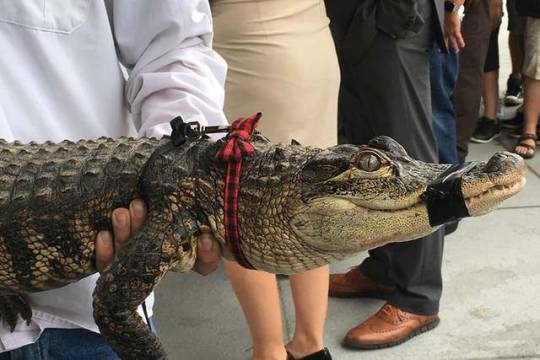
How Do We Prevent Pets from Becoming Exotic Invaders?
Outlawing possession does not appear to stem the release of alligators, snakes and other problematic species
By Jim Daley
October 7, 2019
This summer a professional trapper caught an alligator in a lagoon in Chicago’s Humboldt Park, following a weeklong search that drew crowds of onlookers and captured national headlines. Dubbed “Chance the Snapper,” after a local hip-hop artist, the five-foot, three-inch reptile had likely been let loose by an unprepared pet owner, say experts at the Chicago Herpetological Society (CHS). This was no anomaly: pet gators have recently turned up in a backyard pool on Long Island, at a grocery store parking lot in suburban Pittsburgh (the fourth in that area since May) and again in Chicago.
Keeping a pet alligator is illegal in most U.S. states, but an underground market for these and other exotic animals is thriving—and contributing to the proliferation of invasive species in the U.S. and elsewhere. As online markets make it steadily easier to find unconventional pets such as alligators and monkeys, scientists and policy makers are grappling with how to stop the release of these animals in order to prevent new invasives from establishing themselves and threatening still more ecological havoc. New research suggests that simply banning such pets will not solve the problem and that a combination of education, amnesty programs and fines might be a better approach. Many people who release pets may simply be unaware of the dangers—both to the ecosystem and the animals themselves—says Andrew Rhyne, a marine biologist at Roger Williams University who studies the aquarium fish trade. People may think a released animal is “living a happy, productive life. But the external environment is not a happy place for these animals to live, especially if they’re not from the habitat they’re being released into,” he says. “The vast majority of [these] species suffer greatly and die out in the wild.”
EXOTICS TO INVASIVES
Owners sometimes release alligators, as well as other exotic pets such as snakes and certain varieties of aquarium fish, when they prove too big, aggressive or otherwise difficult to handle. But unleashing them on a nonnative habitat risks letting them establish themselves as an invasive species that can disturb local ecosystems. According to one estimate, nearly 85 percent of the 140 nonnative reptiles and amphibians that disrupted food webs in Florida’s coastal waters between the mid-19th century and 2010 are thought to have been introduced by the exotic pet trade.
A study published in June in Frontiers in Ecology and the Environment found this trade is already responsible for hundreds of nonnative and invasive species establishing themselves in locations around the world. Examples range from Burmese pythons—which can grow more than 15 feet long and dine on local wildlife in the Florida Everglades—to monk parakeets, whose bulky nests atop utility poles and power substations around the U.S. cause frequent fires and outages. And because of the growth of direct-to-consumer marketplaces on Web sites and social media, “the trade in exotic pets is a growing trend,” both in terms of the number of individual animals and the variety of species kept, says study leader Julie Lockwood, a Rutgers University ecologist. “Together, those increase the chances that this market will lead to an invasion” of an exotic species, she says.
To date, the main way officials have tried to combat the problem is with laws that simply prohibit keeping certain categories of animals as pets. But the effectiveness of this approach is unclear. Even though Illinois has outlawed keeping crocodilians as pets for more than a decade, Chance is just one of many CHS has had to deal with this year alone, says its president Rich Crowley. He likens the problem to illegal fireworks, noting that bans on exotic pets are inconsistent from one state to the next. For Illinois residents, “there’s still a supply that is readily available, legally, across the border” in Indiana, he says. “There are people out there who are willing to take the chance of skirting the law because the reward of keeping [these] animals is worth the risk.”New research published recently in Biological Invasions underscores this point, finding that banning the sale and possession of invasive exotic species in Spain did not reduce their release into urban lakes in and around Barcelona. “For these invasive species, legislation for the management of invasions comes too late,” because they have already established themselves in the local environment, says University of Barcelona ecologist Alberto Maceda-Veiga, the report’s lead author.Phil Goss, president of the U.S. Association of Reptile Keepers, says that instead of blanket bans, he would like to see ways for responsible pet owners to still possess exotic species—with laws targeting the specific problem of releasing animals into the wild. “We’re certainly not against all regulation,” he says. “What we’d like to see is something that will punish actual irresponsible owners first rather than punishing all keepers as a whole.”
TRAINING AND TAGGING
Instead of bans, Maceda-Veiga’s study recommends educating buyers of juvenile exotic animals about how large they will eventually grow and taking a permit-issuing approach that requires potential owners to seek training and accreditation. “You need a driving license to drive a car,” and people should be similarly licensed to keep exotic pets, Maceda-Veiga says. He and his co-authors contend that licensing, combined with microchips that could be implanted in pets to identify owners, could curb illegal releases.Rhyne agrees that giving buyers more information would likely help. “I think the education part is really important,” he says. “We should not assume that the average consumer understands (a) how big the animal will get once it’s an adult and (b) what the harm could be if it got out in the wild.” Crowley concurs and says CHS has worked with municipal authorities to make sure pet owners who might have a crocodilian that is getting too big for the bathtub are referred to the organization for assistance. Also, some state agencies offer alternatives to dumping an animal in the wild that protect owners from legal repercussions. Lockwood says devising responsible ways for owners to relinquish such pets could help. But for this to work, “you need to make it as easy as possible” to turn in an animal, she says. In 2006 Florida’s Fish and Wildlife Conservation Commission (FWC) established an amnesty program that allows owners to surrender their exotic pets with no questions asked. So far more than 6,500 animals have been turned over to the program, says Stephanie Krug, a nonnative-species education and outreach specialist at FWC. A few other states have followed Florida’s lead in establishing amnesty initiatives.
Rhyne says some of the onus for controlling exotic animals should fall on the pet industry itself. “If you don’t regulate yourself and make sure you’re doing your best not to trade in species that are highly invasive, you’re going to create a problem that [lawmakers] are going to fix for you,” he adds. Mike Bober, president of the Pet Industry Joint Advisory Council, says the pet care community is considering ways to proactively address the problem. “We look at that being primarily based in education and partnership,” he says.As for what became of Chance, the erstwhile Windy City denizen is acclimating to his new home at the St. Augustine Alligator Farm Zoological Park in Florida. An aerial photograph of the Humboldt Park lagoon adorns his enclosure—but he is back where he belongs.
0 notes
Text
How Do You Move A Crocodilian?
In light of a recent post, you may be wondering: just how CAN zoos move crocodilians without hitting them in the face with a shovel? I linked some good examples in the post above, but here's some more. Sometimes with small crocodilians if you want to move them, you can just... pick them up. Gently and carefully, but you can lift some smaller species without causing them much distress. Of course, there's a lot of trust that needs to be built first, but it can be done! Here's Cincinnati moving their Chinese alligators between habitats.
youtube
Great handling here. Two handlers on the gator at all times, pelvic and pectoral girdles supported, easy release into the water. This is a small species so this is safe, and look how relaxed and easy their body language is!
This is another safe way to move a crocodilian- leading them with a target! Obviously you can't pick up a fully grown American alligator very easily, but here's Brevard Zoo showing you how responsive their big boys are to this kind of training.
youtube
Zoos all over the world use different training techniques to work on their crocs. Here's a nice video from St. Augustine Alligator Farm that shows how they work their gharials to participate in their own healthcare:
youtube
Training is really important for human and animal safety. For the animals, it helps them participate in their own healthcare and know what to expect. It also helps mitigate social tensions, lets you see that every animal is getting the right amount of food, lets you easily work with them in and out of the water (you need to see them on land for an accurate body condition assessment), and provides mental and social stimulation for them.
youtube
But also: if your animals trust you and have some training, it protects both you and them in an emergency. When you work with large carnivores like crocodilians, you need to be able to predict the unpredictable, and be prepared for things to go wrong. Part of that preparation is setting the animals up for success. An animal that's scared of you isn't going to cooperate with medical care. It will be difficult to move in case of an emergency, and it will be harder to maintain control during a worst-case scenario.
If you have to evacuate your facility or something, and you need your croc to go into a carrier box, if it is trained to do that, it's not going to add yet another new, terrifying experience to a pile of new and terrifying experiences. Training is how zookeepers protect themselves and the animals, and when you compare this type of thing to more aversive techniques, it should be fairly easy to see why using the right training techniques is important!
#reptile#reptiblr#crocodilian#alligator behavior#alligator#zoo stuff#maybe in another world i got a job at lousville to work with los cubanos or went to UT and studied them professionally#but man i just love these guys so much#(los cubanos are a specific pair of cuban crocs who are very in love with each other and some of the most beautiful animals i've ever met)
299 notes
·
View notes
Photo

36 Hours in St. Augustine Sunday 9) 9 o'clock. Not just another Gator Farm What began as an impromptu attraction in 1893, when tourists waiting at a stop admired locally captured alligators, has become one of the country's oldest zoos: the St.
0 notes
Photo

Dad: "Don't be climbing in those cages with gators!" Me: Don't worry; I won't. Also Me: . . . #florida #alligator #farm #nature #fl #gators #sorrydad #wanderlust (at St. Augustine Alligator Farm Zoological Park)
1 note
·
View note
Text
I just went to the Alligator Farm in St. Augustine and I got to feed like 250 gators while I was being filmed, haha! It was super rad, they’re so cute!!! 😁🐊
#personal#I haven't been there since I was like 10 omg it was so fun and they've improved the place so much
10 notes
·
View notes
Text
Taking Flight
Across the street from the St Augustine Light Station is the local gator farm. Besides a large population of alligators and crocodiles, they also host quite a few local birds. The trees surrounding the main Alligator swamp is filled with native water birds. We saw a variety of birds including herons, storks, egrets and roseate spoonbills like this one. I spent a few minutes following this…
View On WordPress
1 note
·
View note
Text

Landscaping & Sodding Installation Services In St Augustine https://grassygatoroutdoor.com/ - Grassy Gator offers High Quality, Fast, and Affordable Sod Installation services in St Augustine, FL. They use only local sod farms to ensure your yard looks its best. If you need recommendations they will provide an estimate of the type of grass, and how much you'll need, as well as how long the job will take all for free. For more information, please visit grassygatoroutdoor.com
0 notes